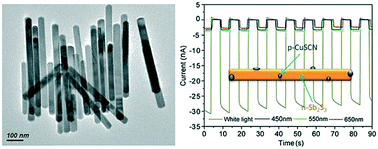Isovalent bismuth ion-induced growth of highly-disperse Sb2S3 nanorods and their composite with p-CuSCN for self-powered photodetectors†
Abstract
Stibnite (Sb2S3) is a promising material in photoelectronic and energy devices, but it frequently exhibits sheaf-like and hierarchical-like structures that consist of secondary nanorods (NRs) or nanowires (NWs) because of its spatial fractal splitting growth habit. Foreign ions or seeds enable the alteration of the growth dynamics and the consequent shape engineering of nanocrystals. We here report that the introduction of trace amounts of isovalent Bi3+ ions (typically 1–2 atom% Bi/Sb) is efficient to synthesize highly disperse, uniform Sb2S3 NRs with reduced diameters and lengths. Two temperature-dependent growth mechanisms stemming from the presence of Bi ions, the full splitting growth at high temperature and the seeded growth at low temperature, are proposed to demonstrate the formation of separated, thinner NRs. Meanwhile, the surfactant removal and the coupling with p-type CuSCN are simultaneously performed on these Sb2S3 NRs, and the resultant CuSCN/Sb2S3 composite, which contains a large amount of point-to-surface contact p–n heterojunctions with a suitable band alignment, holds promise in self-powered UV-visible photodetectors via the photovoltaic effect.



 Please wait while we load your content...
Please wait while we load your content...